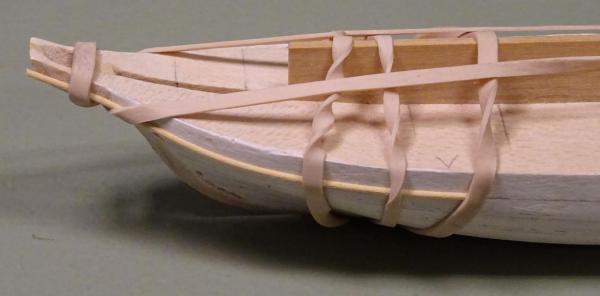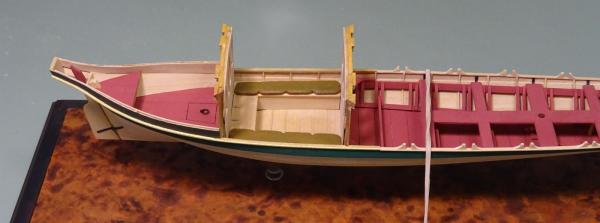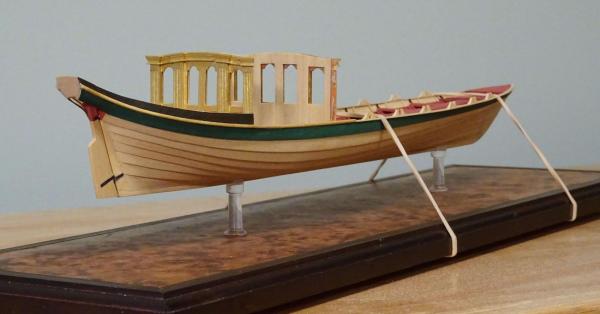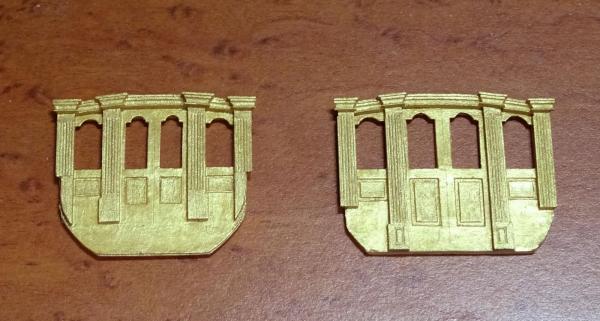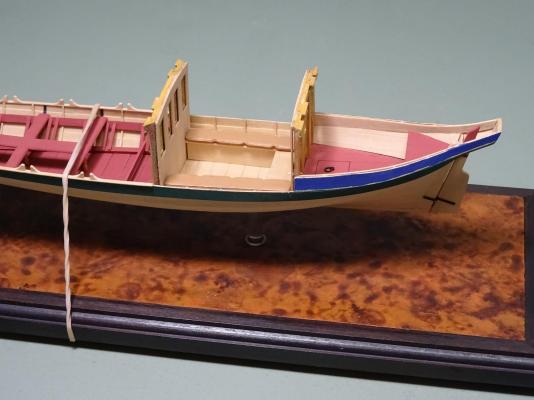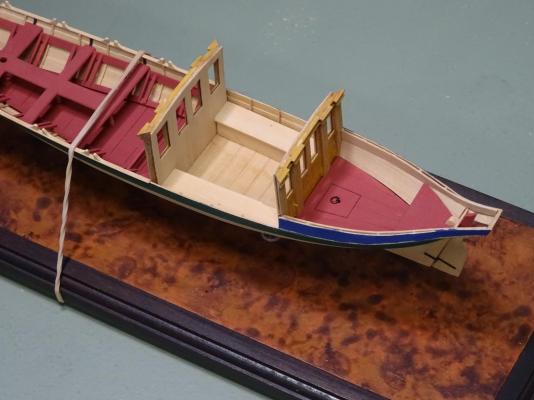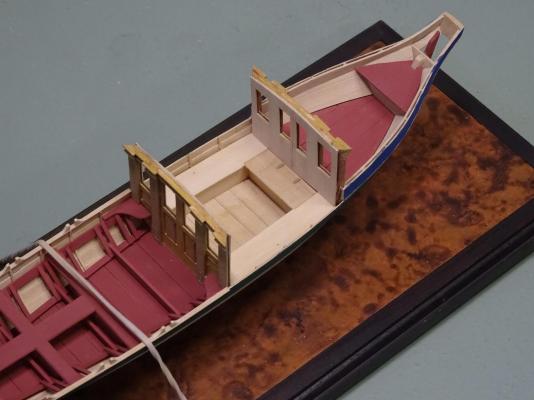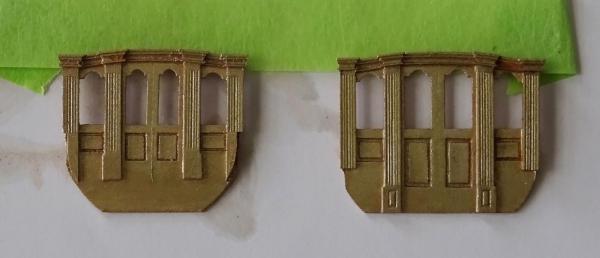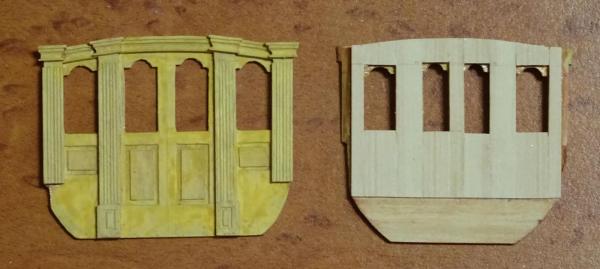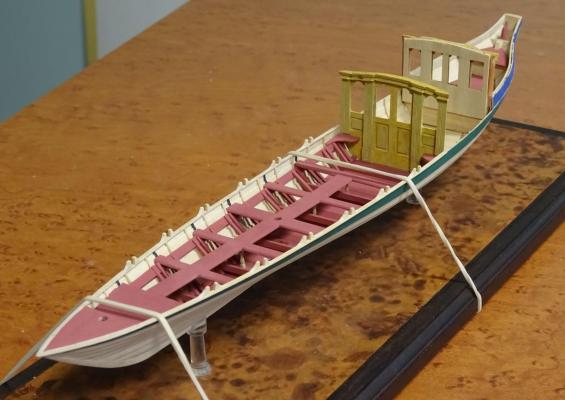-
Posts
13,274 -
Joined
-
Last visited
Content Type
Profiles
Forums
Gallery
Events
Everything posted by druxey
-
It's not so much the brand of chisel, but how well it's sharpened that matters. I use a Lee Valley (Veritas) sharpening system with their jig and stone pond. I have water stones of 1000 and 4000 grit and add a micro-bevel on the edge. The back of the chisel is also polished to a mirror finish. Cutting with a well-sharpened edge produces the sound of a fresh apple being cut and beautiful shavings.
-
Thanks again for all of you who are dropping in on this log. Further progress sees the completion of the gunwale and its extension aft as a moulding. The aft section of gunwale is 1½" thick, rather than ¾". You can see the step up forward of the cabin area. The moulding section was wet-formed on the plug (lowest photo), then painted and applied to the model. It has a C-curve in one plane and an S-curve in the other. It was necessary to complete the gunwale before proceeding with the coach sides. I'm now cutting and fitting card pattern pieces for the coach sides.
- 641 replies
-
- greenwich hospital
- barge
-
(and 1 more)
Tagged with:
-
That looks much more plausible, but it might even be better if the floors and first futtocks were shortened a bit.
- 525 replies
-
- anchor hoy
- hoy
-
(and 1 more)
Tagged with:
-
Thank you for your latest update, Glenn. Before I read the other comments, I too was thinking "She looks about ready to turn over!" That is beautiful work.
-
Horsehair filled...or straw. Finally have solved the gilding issue. After some experimentation I am using Golden artist color brand acrylic tube paint. It is called Iridescent Gold (fine). The particles are much finer than in other brands I've tried. Photographing this is difficult, but the photos give some idea of the result. Keen eyes will notice I've repainted the blue strake a dark green-black, referred to as merde d'oie. (If you don't know French, look this up!)
- 641 replies
-
- greenwich hospital
- barge
-
(and 1 more)
Tagged with:
-
And here are the seat cushions. They were carved from some pear stock 3" thick. The piping along the edges was some fine line left over from another model. It was applied using acrylic matt medium. Had I used white glue, it would have dissolved when I painted the cushions with acrylic paint. I may deepen their color. Experiments with 'gold' are beginning to yield promising results. More soon.
- 641 replies
-
- greenwich hospital
- barge
-
(and 1 more)
Tagged with:
-
Interesting progress, Maury. This futtocks and top timbers seem awfully short to me. I think there would be only one futtock and toptimber per frame pair. See ZAZ4972 in the NMM collection of a hoy, undated.
- 525 replies
-
- anchor hoy
- hoy
-
(and 1 more)
Tagged with:
-
Nicely done scarphs, Frank. However, I believe keel scarphs were always made in the vertical plane.
- 649 replies
-
- dunbrody
- famine ship
-
(and 2 more)
Tagged with:
-
Interesting modification on your Unimat: how is the brass stop secured on the cross-slide rail?
- 3,618 replies
-
- young america
- clipper
-
(and 1 more)
Tagged with:
-
Some progress while I wait for various 'gilding' materials to arrive. The coach benches are made and installed. For the moment the forward and aft coach bulkheads are temporarily slotted into position and still removable. The plan of the coach indicates a locker lid aft. The benches were cushioned for the benefit of the Lord Commissioners' backsides, so these are next. I'll model them based on the ones seen in Prince Frederick's barge
- 641 replies
-
- greenwich hospital
- barge
-
(and 1 more)
Tagged with:
-
Jud: your illustrations appear to show the aft tiller line crossing over the chimney area and so would get cooked.
-
Pat: I used a paintbrush to remove the finish after flooding and softening the paint.
- 641 replies
-
- greenwich hospital
- barge
-
(and 1 more)
Tagged with:
-
Love the tooling and jigs, Gerald! How did you cut out the floor blanks?
- 281 replies
-
- falls of clyde
- tanker
-
(and 2 more)
Tagged with:
-

Cutter Cheerful 1806 by rafine - FINISHED
druxey replied to rafine's topic in - Build logs for subjects built 1801 - 1850
Those belayed lines look terrific, Bob.- 525 replies
-
- cheerful
- Syren Ship Model Company
-
(and 1 more)
Tagged with:
-
Thanks for the tips and support, everyone. It is much appreciated. I will be experimenting with different 'gilt' finishes over the next few days. The first photograph shows the ends finished in gold paint. This was unacceptable, as previously mentioned. The second picture shows the inner side of one end piece and the other stripped of finish. There is a channel running across the lights between the layers which will enable me to slide the frames for the lights and glazing in after I finish the outer sides. The third photograph shows the ends of the coach temporarily in place. After the seating is in place the ends will be permanently installed and the sides constructed to a sliding fit. Next be to constructed will be the seating inside the coach.
- 641 replies
-
- greenwich hospital
- barge
-
(and 1 more)
Tagged with:
-
Thanks for all these ideas, everyone. I'll try them out. I seem to recall using Buff 'n' Rub years ago on some picture frames. The low sheen it produced may be exactly what I'm after.
- 641 replies
-
- greenwich hospital
- barge
-
(and 1 more)
Tagged with:
-
Well, no photos this time. I've been struggling with gilded finish for the coach. I first tried Humbrol gold paint. The look was too coppery red, 'grainy' and glossy. I stripped this off and sprayed using a yellower gold lacquer. Still far too shiny and grainy - it does not look right at this scale. I've just stripped this off using acetone (ugh!) in a well ventilated garage. I will experiment further. Gold leaf was one possibility, but it will reflect and magnify any tiny surface defect or dust mote. So... back to the workbench.
- 641 replies
-
- greenwich hospital
- barge
-
(and 1 more)
Tagged with:
-
Just catching up, Bill. Good on you to do a re-work. That method of decking looked lovely while it lasted, though!
- 382 replies
-
- sovereign of the seas
- carving
-
(and 1 more)
Tagged with:
-
Consider dye or paint when you make the wales, Mike. Ebony is a b*gg*r from every point of view, as others have mentioned.
- 967 replies
-
- hahn
- oliver cromwell
-
(and 1 more)
Tagged with:
-
Thank you, gentlemen, for your kind remarks. Dan: I'm basing my ideas on the Prince Frederick's barge in the NMM. This has glazed sash lights and ornamental drapes in the corners of the coach.
- 641 replies
-
- greenwich hospital
- barge
-
(and 1 more)
Tagged with:
About us
Modelshipworld - Advancing Ship Modeling through Research
SSL Secured
Your security is important for us so this Website is SSL-Secured
NRG Mailing Address
Nautical Research Guild
237 South Lincoln Street
Westmont IL, 60559-1917
Model Ship World ® and the MSW logo are Registered Trademarks, and belong to the Nautical Research Guild (United States Patent and Trademark Office: No. 6,929,264 & No. 6,929,274, registered Dec. 20, 2022)
Helpful Links
About the NRG
If you enjoy building ship models that are historically accurate as well as beautiful, then The Nautical Research Guild (NRG) is just right for you.
The Guild is a non-profit educational organization whose mission is to “Advance Ship Modeling Through Research”. We provide support to our members in their efforts to raise the quality of their model ships.
The Nautical Research Guild has published our world-renowned quarterly magazine, The Nautical Research Journal, since 1955. The pages of the Journal are full of articles by accomplished ship modelers who show you how they create those exquisite details on their models, and by maritime historians who show you the correct details to build. The Journal is available in both print and digital editions. Go to the NRG web site (www.thenrg.org) to download a complimentary digital copy of the Journal. The NRG also publishes plan sets, books and compilations of back issues of the Journal and the former Ships in Scale and Model Ship Builder magazines.



